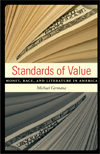Standards of Value
“In a lively, engaging style, Michael Germana demonstrates the cultural and linguistic turn that took place when a select group of American novelists constructed analogies between money and race. In doing so, Standards of Value examines how those analogies both enabled and disabled the renegotiation of racial ‘value’ from the mid-nineteenth to the mid-twentieth century. This is an important contribution to both U.S. literary studies and new economic cultural studies more generally.”—Lori Merish, author, Sentimental Materialism: Gender, Commodity Culture, and Nineteenth-Century American Literature
“As Michael Germana lays the groundwork for close readings of individual texts, his well-written study, free of jargon, guides even the general reader expertly through the intricacies of American monetary policy.”—Hildegard Hoeller, coauthor, Key Words for Academic Writers
In Standards of Value, Michael Germana reveals how tectonic shifts in U.S. monetary policy—from the Coinage Act of 1834 to the abolition of the domestic gold standard in 1933–34—correspond to strategic changes by American writers who renegotiated the value of racial difference. Populating the pages of this bold and innovative study are authors as varied as Harriet Beecher Stowe, George Washington Cable, Charles Chesnutt, James Weldon Johnson, Nella Larsen, Jessie Redmon Fauset, and Ralph Ellison—all of whom drew analogies between the form Americans thought the nation's money should take and the form they thought race relations and the nation should take.
A cultural history of race organized around and enmeshed within the theories of literary and monetary value, Standards of Value also recovers a rhetorical tradition in American culture whose echoes can be found in the visual and lyrical grammars of hip hop, the paintings of John W. Jones and Michael Ray Charles, the cinematography of Spike Lee, and many other contemporary forms and texts.
This reconsideration of American literature and cultural history has implications for how we value literary texts and how we read shifting standards of value. In vivid prose, Germana explains why dollars and cents appear where black and white bodies meet in American novels, how U.S. monetary policy gave these symbols their cultural currency, and why it matters for scholars of literary and cultural studies.
Acknowledgments ix
Introduction 1
1. Jacksonian Abolitionism: Money, Minstrelsy, and
“Uncle Tom’s Cabin” 19
2. Real Change: George Washington Cable’s
“The Grandissimes” and the Crime of ’73 53
3. The Gold Standard of the Passing Novel:
Exploring the Limits of Strategic Essentialism 80
4. Black Is . . . an’ Black Ain’t: “Invisible Man” and
the Fiat of Race 115
Conclusion 147
Notes 157
Bibliography 175
Index 185




